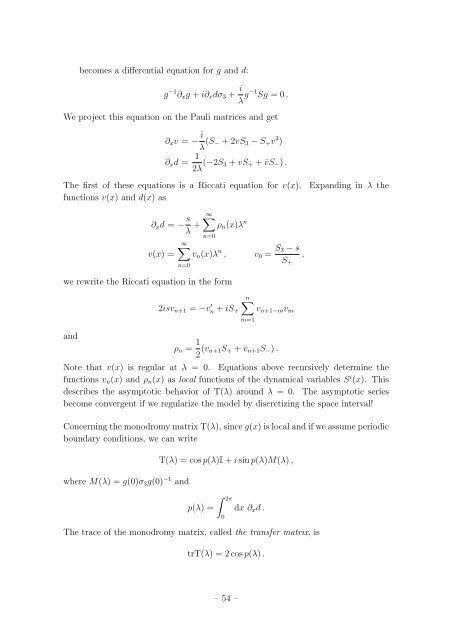Student Seminar: Classical and Quantum Integrable Systems
Student Seminar: Classical and Quantum Integrable Systems
Student Seminar: Classical and Quantum Integrable Systems
Create successful ePaper yourself
Turn your PDF publications into a flip-book with our unique Google optimized e-Paper software.
ecomes a differential equation for g <strong>and</strong> d:<br />
g −1 ∂ x g + i∂ x dσ 3 + i λ g−1 Sg = 0 .<br />
We project this equation on the Pauli matrices <strong>and</strong> get<br />
∂ x v = − i λ (S − + 2vS 3 − S + v 2 )<br />
∂ x d = 1<br />
2λ (−2S 3 + vS + + ¯vS − ) .<br />
The first of these equations is a Riccati equation for v(x).<br />
functions v(x) <strong>and</strong> d(x) as<br />
Exp<strong>and</strong>ing in λ the<br />
∂ x d = − s ∞<br />
λ + ∑<br />
ρ n (x)λ n<br />
v(x) =<br />
n=0<br />
∞∑<br />
v n (x)λ n ,<br />
n=0<br />
v 0 = S 3 − s<br />
S +<br />
,<br />
we rewrite the Riccati equation in the form<br />
n∑<br />
2isv n+1 = −v n ′ + iS + v n+1−m v m<br />
m=1<br />
<strong>and</strong><br />
ρ n = 1 2 (v n+1S + + ¯v n+1 S − ) .<br />
Note that v(x) is regular at λ = 0. Equations above recursively determine the<br />
functions v n (x) <strong>and</strong> ρ n (x) as local functions of the dynamical variables S i (x). This<br />
describes the asymptotic behavior of T(λ) around λ = 0. The asymptotic series<br />
become convergent if we regularize the model by discretizing the space interval!<br />
Concerning the monodromy matrix T(λ), since g(x) is local <strong>and</strong> if we assume periodic<br />
boundary conditions, we can write<br />
where M(λ) = g(0)σ 3 g(0) −1 <strong>and</strong><br />
T(λ) = cos p(λ)I + i sin p(λ)M(λ) ,<br />
p(λ) =<br />
∫ 2π<br />
0<br />
dx ∂ x d .<br />
The trace of the monodromy matrix, called the transfer matrix, is<br />
trT(λ) = 2 cos p(λ) .<br />
– 54 –

















